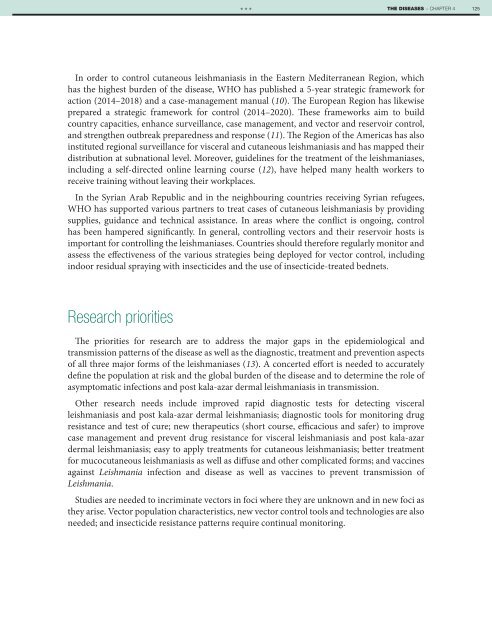1A9bnbK
1A9bnbK
1A9bnbK
Create successful ePaper yourself
Turn your PDF publications into a flip-book with our unique Google optimized e-Paper software.
***<br />
THE DISEASES − CHAPTER 4<br />
125<br />
In order to control cutaneous leishmaniasis in the Eastern Mediterranean Region, which<br />
has the highest burden of the disease, WHO has published a 5-year strategic framework for<br />
action (2014–2018) and a case-management manual (10). The European Region has likewise<br />
prepared a strategic framework for control (2014–2020). These frameworks aim to build<br />
country capacities, enhance surveillance, case management, and vector and reservoir control,<br />
and strengthen outbreak preparedness and response (11). The Region of the Americas has also<br />
instituted regional surveillance for visceral and cutaneous leishmaniasis and has mapped their<br />
distribution at subnational level. Moreover, guidelines for the treatment of the leishmaniases,<br />
including a self-directed online learning course (12), have helped many health workers to<br />
receive training without leaving their workplaces.<br />
In the Syrian Arab Republic and in the neighbouring countries receiving Syrian refugees,<br />
WHO has supported various partners to treat cases of cutaneous leishmaniasis by providing<br />
supplies, guidance and technical assistance. In areas where the conflict is ongoing, control<br />
has been hampered significantly. In general, controlling vectors and their reservoir hosts is<br />
important for controlling the leishmaniases. Countries should therefore regularly monitor and<br />
assess the effectiveness of the various strategies being deployed for vector control, including<br />
indoor residual spraying with insecticides and the use of insecticide-treated bednets.<br />
Research priorities<br />
The priorities for research are to address the major gaps in the epidemiological and<br />
transmission patterns of the disease as well as the diagnostic, treatment and prevention aspects<br />
of all three major forms of the leishmaniases (13). A concerted effort is needed to accurately<br />
define the population at risk and the global burden of the disease and to determine the role of<br />
asymptomatic infections and post kala-azar dermal leishmaniasis in transmission.<br />
Other research needs include improved rapid diagnostic tests for detecting visceral<br />
leishmaniasis and post kala-azar dermal leishmaniasis; diagnostic tools for monitoring drug<br />
resistance and test of cure; new therapeutics (short course, efficacious and safer) to improve<br />
case management and prevent drug resistance for visceral leishmaniasis and post kala-azar<br />
dermal leishmaniasis; easy to apply treatments for cutaneous leishmaniasis; better treatment<br />
for mucocutaneous leishmaniasis as well as diffuse and other complicated forms; and vaccines<br />
against Leishmania infection and disease as well as vaccines to prevent transmission of<br />
Leishmania.<br />
Studies are needed to incriminate vectors in foci where they are unknown and in new foci as<br />
they arise. Vector population characteristics, new vector control tools and technologies are also<br />
needed; and insecticide resistance patterns require continual monitoring.


